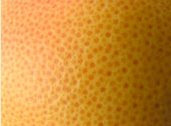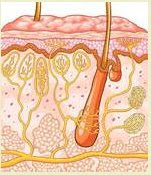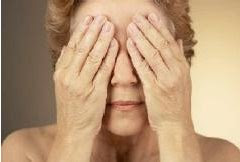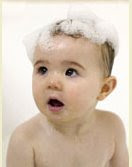 Knowing and understanding your skin, the bodies largest organ, will help you to achieve a naturally beautiful you. An effective natural skin care program begins with understanding what factors and influences affect the appearance and condition of your skin.
Knowing and understanding your skin, the bodies largest organ, will help you to achieve a naturally beautiful you. An effective natural skin care program begins with understanding what factors and influences affect the appearance and condition of your skin.The skin is 'built' in layers, kinda like a sandwich. It covers an average of eighteen square feet and weighs approximately seven pounds. Now THAT is a lot of skin!
The layers of your skin are called the epidermis, dermis, and the subcutaneous layers.
The epidermis is the naturally beautiful outer layer of skin. It is what we see when we look into the mirror. Errr....well, maybe we don't always see the naturally beautiful part (I sure didn't for a long long time).
into the mirror. Errr....well, maybe we don't always see the naturally beautiful part (I sure didn't for a long long time).
 into the mirror. Errr....well, maybe we don't always see the naturally beautiful part (I sure didn't for a long long time).
into the mirror. Errr....well, maybe we don't always see the naturally beautiful part (I sure didn't for a long long time).The epidermis is the part of your skin that will blister, flake, burn, wrinkle and break out. It is composed of tightly packed, scale-like cells which are continually being shed. An entirely new epidermis is formed approximately every twenty-eight days and this rate will slow as you age. This shedding process is why exfoliation is important for a naturally beautiful appearance.
Melanin in the epidermis gives your skin its color and it protects the underlying layers from the damaging effects of the sun. The epidermis is covered with a thin layer of natural oil and perspiration that is called the acid mantle.
 The acid mantle has an average pH of 4.5 to 5.5, and it protects your skin against bacteria. Oily skin is usually less acidic; dry skin tends to be more acidic. You need to keep your skin's pH balanced to keep it protected. A freshener or toner will help keep the pH balanced in your skin for a naturally beautiful you.
The acid mantle has an average pH of 4.5 to 5.5, and it protects your skin against bacteria. Oily skin is usually less acidic; dry skin tends to be more acidic. You need to keep your skin's pH balanced to keep it protected. A freshener or toner will help keep the pH balanced in your skin for a naturally beautiful you.The dermis is the middle layer of your skin, it is also know as the "true skin". This is where the  collagen and elastin fibers give the skin its strength and flexibility. This is the layer where the effects of aging and improper care take hold.
collagen and elastin fibers give the skin its strength and flexibility. This is the layer where the effects of aging and improper care take hold.
 collagen and elastin fibers give the skin its strength and flexibility. This is the layer where the effects of aging and improper care take hold.
collagen and elastin fibers give the skin its strength and flexibility. This is the layer where the effects of aging and improper care take hold.Unfortunately, as you age, both collagen and elastin tend to become stiff, tangles and frayed. Much of the sagging and wrinkling you see in older skin is the result of damaged and weakened collagen and elastin. Not to worry, there is help for a naturally beautiful you.
Below the dermis is the third layer of your skin called the subcutaneous layer. It is made of a fatty tissue that gives your skin its contour and smoothness. These three layers together - epidermis, dermis, and subcutanea - form your skin.
Your skin is at work 24 hours a day: it regulates your body temperature, detoxifies your body by excreting wastes, breathes, absorbs nutrients, and protects your body from ultraviolet damage from the sun.
 Do you remember the naturally beautiful, soft, smooth skin you had as a child? That youthful softness and glow was the result of high moisture content--approximately 90% water.
Do you remember the naturally beautiful, soft, smooth skin you had as a child? That youthful softness and glow was the result of high moisture content--approximately 90% water.The amount of water in the skin is dependent on the middle layer of the epidermis, called the stratum corneum. This area is thought to contain water attracting compounds we call natural moisturizing factors (NMF).
As you grow older, the amount of NMFs in the skin decrease through the natural process of dehydration. This decline is believed to be one of the reasons that the skin becomes drier and begins to look older as the years go by.
Check back tommorrow to find out how to keep your skin naturally beautiful.

Have a sunny day!